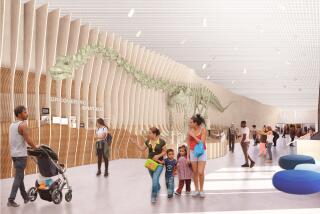2 Scientists Put the Roar in the Dinosaur
- Share via
An unusual alliance between researchers at the New Mexico Museum of Natural History and Science and the Sandia National Laboratory has digitally reproduced the voice of the parasaurolophus dinosaur.
The experiment was made possible after the August 1995 discovery of an unusually well-preserved parasaurolophus skull. The specimen, found in Farmington, N.M., includes a nearly complete crest--a distinctive feature of the duck-billed, herbivorous parasaurolophus.
Parasaurolophus’ tubular crest extended more than three feet behind the top of its head. The crest was not solid, but rather contained a network of cavities, tubes and soft tissues that connected to the creature’s airways and breathing system.
“Although the function of these crests is still uncertain . . . the presence of long air passageways indicates that they could have been used as acoustic resonators to produce specific sounds,” said Tom Williamson, a New Mexico Museum paleontologist, who conceived the Parasaurolophus Sound Project with Sandia computer scientist Carl Diegert.
The scientists believe research in the emerging field of digital paleontology could ultimately impact the fields of air safety, tomography-assisted surgery and nuclear weapons safety monitoring.
To resurrect the parasaurolophus sound, Diegert and Williamson made a three-dimensional computer model of the crest by performing a CAT scan on it at St. Joseph Medical Center in Albuquerque.
About 350 cross-sections were taken of the skull and crest at 3-millimeter intervals. The results revealed a much more complicated internal structure than paleontologists had previously thought existed.
To reconstruct an intact crest, the scientists loaded the cross-sections in numerical form into a computer. After studying the images, Diegert and Williamson programmed the computer to read their density to distinguish between what was bone and what was the sandstone and clay that typically fill and encase fossils.
Once the size and shape of the air passages were established, the researchers could determine the frequency of the sound waves the dinosaur produced.
The resulting sound was large and resonant, reminiscent of a fog horn or a giant tuba. “A very complex shape such as the dinosaur crest takes lots and lots of numbers to describe the shape in the computer,” says Diegert. “It’s only recently [that] computers have become powerful enough to allow that to happen.”
The scientists hope one day to create a digital databank of dinosaur sounds. More information on the project can be found on the Internet at https://www.sandia.gov
More to Read
Sign up for Essential California
The most important California stories and recommendations in your inbox every morning.
You may occasionally receive promotional content from the Los Angeles Times.













